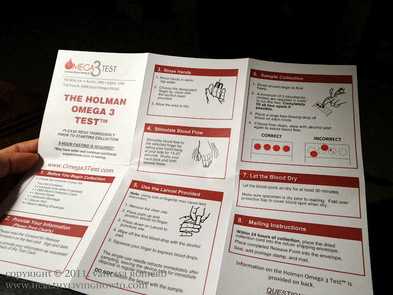Yesterday, in Oh Mega: Part One, we began a discussion about essential fatty acids, specifically Omega-6 and Omega-3 and the role they play in health as well as the disease process. We concluded that while some Omega-6 is essential, in excess it can be harmful and that for optimal health we need a balance of Omega-6 to Omega-3.
Research suggests an ideal Omega 6:3 ratio somewhere along the lines of 4:1 to 1:1. Due to the current high consumption of processed foods and consumption of polyunsaturated oils like corn oil, safflower oil, sunflower oil, soybean oil, cottonseed oil, sesame oil, and peanut oil, the typical American has a ratio of 17-30:1. This high ratio is directly responsible for the chronic inflammation which leads to disease.
Finally we concluded, to reduce inflammation, not only do we need to reduce the amount of Omega-6 in our diet, we also need to increase the amount of Omega-3.
Late last fall, I had the opportunity to have the Holman Omega-3 Test performed. This test identifies your complete fatty acid profile, focusing on Omega-6 and Omega-3. I also discussed my results with renowned Omega-3 expert Dr. Doug Bibus.
In the mail I received the test kit which included instructions, an alcohol swab, two lancets, a blotting card and a bandage. There was also a return envelope and a small questionnaire about Omega-3 intake. No special preparation was required prior to the sample, a simple prick of the finger and dotting the blood on the collection card. Once dry, in the provided envelope it went and then off to the lab to be tested. My results were e-mailed to me within a week or so.
- Omega-3 Score — My Result = 14.14% — Avg USA 4.8% — Optimal >9%
- Omega-3 HUFA — My Result = 57% — Avg USA 24% — Optimal >50%
- Omega-6 HUFA — My Result = 43% — Avg USA 76% — Optimal <50%
- Omega 6:3 Ratio — My Result 2.5:1 — Avg USA 20:1 — Optimal <4:1
Total Omega-3 Score = 14.4%
The Total Omega-3 Score is generated from the measured amount of Omega-3 in the bloodstream. It is described as a percentage. The total is composed of alpha-linolenic acid (ALA) and it's sythesized fatty acids eicosapentaenoic acid (EPA), docosapentaenoic acid (DPA) and docosahexaenoic acid (DHA). Don't worry if this doesn't mean anything to you, we'll discuss this more in Oh Mega: Part Three.
Omega-3 HUFA Test = 57%
Also known as the Lands' Test, named after Dr. Bill Lands who invented it. Highly unsaturated fatty acids (HUFA) form the basis of our inflammatory response system. The inflammatory response produced from Omega-6 is remarkably powerful meanwhile the Omega-3 is anti-inflammatory. Dr. Lands established a lower Omega-6 HUFA with a higher Omega-3 HUFA is ideal.
Omega-3 Index = 11.8
The Omega-3 index is the combined value of two Omega-3 fatty acids, EPA and DHA, thought to be responsible for the main physiological effects of Omega-3 in the diet. It is a blood-based risk factor for projecting cardiovascular disease risks. The recommended Omega-3 index is 8% or greater.
Omega 6:3 Ratio
Excessive amounts of Omega-6 and a very high O6:3 ratio, promotes the development of many diseases, including cardiovascular disease, cancer as well as inflammatory and autoimmune diseases. Whereas increased levels of Omega-3s and a low O6:3 ratio eliminates or lessens the risk.
“Vanessa, you have a SUPER Omega-3 profile.
Maintain your present Omega-3 strategy!”
~Dr. Doug Bibus
SHORT Q & A WITH RENOWNED OMEGA-3 EXPERT DR. DOUG BIBUS
Q: I tend towards a low-carb, paleo type diet. In the “paleo” community there is a strong discouragement of eating nuts due to their Omega-6 content. What is your opinion on eating nuts?
A: One of my close friends is Steve Phinney who wrote the latest Atkins book and now the Art and Science of Low Carb Living with my other buddy, Jeff Volek. They both live on low carb and nuts are a big part of their diet. I think you are fine with some nuts in your diet. Yes, nuts contain Omega-6 so if you enjoy them (and there are a nutritious reasons to enjoy them) just add more Omega-3 to your diet. Omega-3 testing can also help guide you as to whether your nut and Omega-6 intake is impacting healthy levels of Omega-3. Your Omega-3 numbers were awesome, so I don't think your nut intake is hurting your status at all.
Q: Just so I understand, you are saying that adding Omega-3 suppresses Omega-6, so if I choose to eat nuts, I “may” need to supplement with more Omega-3?
A: I am from the camp that more is better for Omega-3. In extreme examples of intake in First Nations or Inuit people living on marine based diets, dietary intake of long chain Omega-3 can reach 20g per day. These folks are also typically on a LC diet. I recommend 2000mg of long chain Omega-3 per day and a smattering of ground flax. This is a meaningful level that will move the rock (increase your Omega-3 blood levels) and if you miss a day or two a week, it will balance out your overall intake to greater than 1000mg. FDA says that up to 3000mg of EPA and DHA per day is safe. I take 3-4000mg, 5 days per week.
Q: What about just eating less Omega-6 as a way to increase Omega-3 levels?
A: Reducing Omega-6 intake is a healthy way to increase Omega-3 levels. One of the highest Omega-3 levels I have ever measured was in a young man living on 3-4# of grass-fed beef per day. The ratio of the beef was 1:1, Omega-6 to Omega 3. One of my competitors advocates a high Omega-6 diet and states that reducing Omega-6 will not increase omega 3 levels….this is simply not true.
Q: As a low-carb and gluten-free food blogger, I use almond flour, coconut flour and flaxseed meal in my baking. Should I be concerned with oxidation? What is your opinion on baking with nut flours and flaxseed meal?
A: I think baking with ground flax and almond flour is a great option so long as it is stable. Flax has 40% oil by mass and 50% of that is ALA which can oxidize. Poorly prepared flax meal will oxidize. Almonds have more linoleic acid and are less prone to oxidation than ALA in flax. As long as heat is not excessive, over 325-350º F, you should be fine.
Do you want to have the Holman Omega-3 Test done?
Dr. Bibus & Lipid Technologies is offering a
50% off discount to Healthy Living How To readers.
Normally $200, you can purchase this test for $100.
Leave a comment and I will e-mail you the discount code.
www.omega3test.com
We will discuss dietary strategies to improve Omega-3 status.

